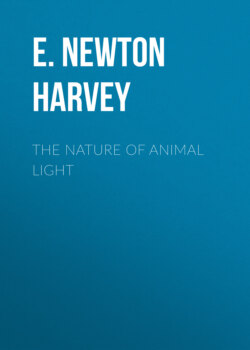Читать книгу The Nature of Animal Light - E. Newton Harvey - Страница 5
На сайте Литреса книга снята с продажи.
CHAPTER II
LUMINESCENCE AND INCANDESCENCE
ОглавлениеTable of Contents
Modern physical theory supposes that light is a succession of wave pulses in the ether caused by vibrating electrons. The light to which we are most accustomed—sunlight, electric light, gaslight, etc.—is due to electrical phenomena connected more or less directly with the high temperature of the source of the light. Every solid body above the temperature of absolute zero is giving off waves of different wave-length (λ) and frequency (ν) but of the same velocity (υ), in vacuo, 180,000 miles, or 300,000 kilometres a second. In fact, υ (a constant)=λν, so that it is only necessary to designate the wave-length in order to characterize the waves. This is radiant energy or radiant flux.
As everyone knows, the long waves given off in largest amount from objects at comparatively low temperatures give the sensation of warmth. As we raise the temperature, in addition to these longer heat waves, those of shorter and shorter wave-length are given off in sufficient quantity to be detected. At 525° C., rays of about λ=.76µ in length are just visible as a faint red glow to the eye. As the temperature increases still shorter wave-lengths become apparent, and the light changes to dark red (700°), cherry red (900°), dark yellow (1100°), bright yellow (1200°), white-hot (1300°) and blue-white (1400° and above). Above λ=.4µ the waves again fail to affect our eye, and, although they are very active in producing chemical changes, we have no sense organs for perceiving them. Thus, a white-hot object liberates radiant energy or flux of many different wave-lengths corresponding to what we know as "heat, light and actinic rays." All can be dispersed by prisms of one or another appropriate material to form a wide continuous spectrum, such as that indicated in Fig. 1. Radiant energy of λ=.76µ to λ=.4µ, evaluated according to its capacity to produce the sensation of light, is spoken of as visible radiation or luminous flux.
Below the infra-red comes a region of wave-length as yet uninvestigated, and beyond this may be placed the Hertzian electric waves of long wave-length used in wireless telegraphy. Above the ultra-violet comes another region as yet uninvestigated, and then Röntgen rays (X-rays) and radium rays, of exceedingly short wave-length. These last types need not concern us except in that we may later inquire if they are given off by luminous animals. The shortest of the ultra-violet are known as Schumann and Lyman rays. These relations are brought out in Table 2.
TABLE 2. Wave-lengths of Various Kinds of Radiation
Wave-lengths of light are usually given in Ångstrom units. One micron (µ)=.001 mm.=1000 millimicrons (µµ)=10,000 Ångstrom units (Å) or tenth metres=10−10 metres or 10−8 centimetres. The entire scale of wave-lengths extends from 106 to 10−9 centimetres.
